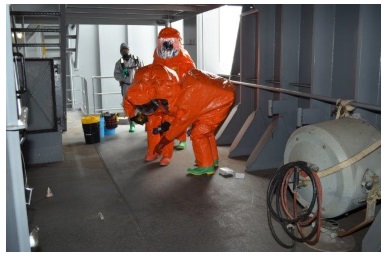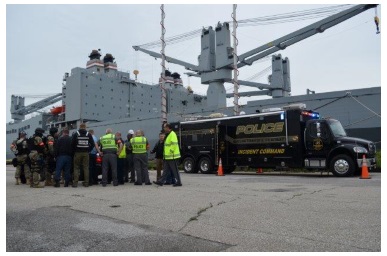Emergency Preparedness: Baltimore
![]() Print this Article | Send to Colleague
Print this Article | Send to Colleague

Hazmat team aboard USNS Antares during hazardous response training exercise in Baltimore
Photo/Dave Espie
A multi-jurisdictional All Hazards Response Training (AHRT) National Level Exercise (NLE) involving 108 emergency responders from seven local, county, state, regional and federal agencies was held May 18 in the Port of Baltimore by the National Strategic Research Institute (NSRI).
NSRI is a University Affiliated Research Center (UARC) affiliated with the University of Nebraska with offices at U.S. Strategic Command (USSTRATCOM) Headquarters at Offutt Air Force Base (NE) and Savage (MD).
Participants included the Maryland Port Administration (MPA), Maryland Transportation Authority (MDTA) Police, Baltimore City Fire, Federal Bureau of Investigation (FBI), Howard County Department of Fire and Rescue Services (HCDFRS) Special Operations, Pennsylvania National Guard's 3rd Civil Support Team (CST) and the U.S. Maritime Administration (MARAD).
"It was an excellent opportunity for the Port of Baltimore to team up with NSRI for this outstanding exercise," said MPA Director of Security David Espie. "Effectively responding to any incident requires sound communication and coordination with local and federal partners. Exercises like this go a long way to ensure you are prepared to meet those challenges that our world presents today and tomorrow."
The high security harbor location provided a backdrop for the complete cradle to grave exercise. The port administration hosted the location, a docking station at North Locust Point Marine Terminal.
USNS Antares, a U.S. Navy Fast Sealift Ship maintained in ready reserve status by MARAD in Baltimore, offered a real-world facility for the scenario.
A mock clandestine laboratory operation was installed in one of the ship’s staterooms. One NSRI advisor staffed the ship with a mock opposition force comprised of shipmates, while another staged the ship with nefarious items and mock, clandestine weapons of mass destruction (WMD) production laboratory as well as other sample evidence. An NSRI advisor ensured that responding law enforcement agencies and HAZMAT personnel adhered to operational guidelines and agency standard operating procedures during multiple phases throughout the day. Active roles in the scenario were played by the ship’s master, engineer, and first mate.
The responders teamed together in a test of their counter-WMD preparedness and readiness including response to suspicious activity, hostile environments and hazardous materials. On scene with the responders were their Special Service Vehicle (SSV) fleets, including Incident Command trucks, mobile command trailers, Special Response Team (SRT) assets, Medical Response Vehicles (MRV’s), mobile laboratory, survey and decontamination (DECON) trucks and a Utility Terrain Vehicle (UTV) outfitted with flash point detectors (used by a survey entry team).
Equipment ranged from communications technology, tactical, protective and laboratory sampling/testing gear to HAZMAT decontamination lines. Exercise participants reflected the range of crucial CBRNE weapons expertise and capability.
The exercise facilitated a better understanding of the requirements necessary to successfully counter a WMD event. In this particular scenario, unknown WMD agents were being produced by an armed, hostile threat; a mock shipmate, aboard the Antares. The ship’s master initiated the investigation that led off the exercise.
As the exercise progressed, the unknown WMD agents were successfully secured, collected and identified. Each agency played a part in utilizing local, state and federal resources to secure the scene and collect environmental samples for analysis and criminal prosecution. Participants exercised sampling operations with local first responders, the FBI, Laboratory Response Network (LRN) and CST. Also drilled were crisis communication procedures between relevant local, state and federal partner agencies.
"The training exercise was an excellent opportunity to train with other agencies," said CPT Arthur Prough, operations officer with Pennsylvania National Guard's 3rd Civil Support Team. "If there's an incident, you don't want that to be your first time working together. You get to know other agency's idiosyncrasies, so it's good to do these exercises and work together. It's also not every day we have access to a real ship as a training ground, unlike a mock training building. We were offered a very real-world, valuable training experience."
"Members of the Maryland Transportation Authority Police's Tactical Command and Port Detachment were pleased to have the opportunity to participate in the NSRI’s training exercise," said MDTA Major Antonio Rodriguez. "These types of exercises help us prepare for emergencies, identify our effectiveness during crises and evaluate our preparedness for different tactical and disaster scenarios. Any time that you can test your emergency preparedness and asset coordination based on realistic scenarios is a plus."

Response training underway at Baltimore's North Locust Point Marine Terminal supported by the Navy fast sealift ship USNS Antares.
Photo/ Dave Espie

